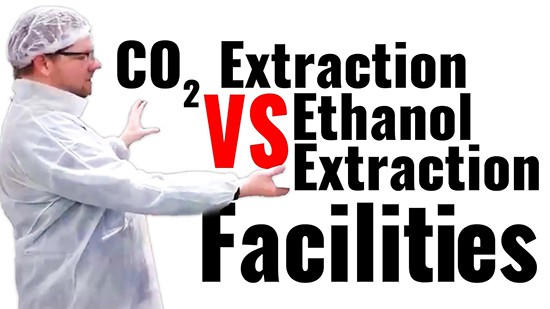Estimated CO2 vs Ethanol Extraction Yearly Operating Costs
Calculate your yearly operating costs of CO2 vs Ethanol extraction using our estimator tool.
How Much CBD Oil Can One Plant Produce?
CBD products have a wide variety of benefits ranging from pain and body alleviation to mental clarity. Since each product has great value and a unique purpose, it is important to recognize exactly how much CBD oil from one plant can be generated. This is especially important in manufacturing and determining how potent your product is going to be.
While the question of how much CBD oil does one plant produce isn’t a specifically easy one to answer, the average single hemp plant can produce roughly one pound of crude CBD oil. Crude CBD oil is the raw hemp product; thus, it can be further processed into purer CBD extracts to create the highest quality products.
Additionally, one acre of hemp plants can generate up to 200 pounds of crude CBD oil or 1,500 pounds of flower, leaving you with an approximate profit of $27,000. Even with operating costs, manufacturing expenses, and buying different types of equipment, a hefty profit can be made from producing your hemp plant and processing it into CBD oil.
Processing CBD into a finer product or isolate oil can leave you with less product, but enhanced potency.
Adjust slider values in order to represent your specific business.
Factors That Affect Hemp Product Output
There are varying factors that can affect or determine the quality and quantity of hemp extracts and how much CBD oil from one plant can be produced. The quality of the plant, whether it was grown under desirable conditions and harvested with care, can impact the overall quality of the hemp extract.
The strain of the hemp plant will also determine the quantity of THC (Tetrahydrocannabinol) in each extract, which can also impact the supply and demand of your products due to legal jurisdictions. This can be a critical factor to consider depending on where your business is located and where your products are being sold. In legal cannabis states, higher levels of THC may be desired where they are legally sold. In other jurisdictions, higher THC levels can cause your business to be shut down due to local laws and regulations.
Processing procedures and equipment are some of the final crucial components in predicting the quantity and quality of your CBD products and how much CBD oil from one plant can be made.
Make sure to follow extraktLAB’s method for extracting the most profitable CBD and CO2 oil from the high-quality supercritical CO2 extractor to ensure that manufacturing goes smoothly.
Talk to an expert today to understand the proper environment and steps to take to yield high-quality CBD extracts.
Ethanol extraction operating costs are two times more than CO2 extraction operating costs. This means your business could be at a loss in the first 2-4-months if you’re using ethanol extraction. Equipment cost for the CO2 oil extraction method is approximately two times more than the ethanol extraction method, but the CO2 process has fewer hidden long term operational costs.
The estimated ethanol equipment cost is approximately $2 million, while the cost of CO2 equipment is around $4 million. Infrastructure fees for the ethanol process are drastic – a hefty $200 per square foot of area. However, the CO2 infrastructure cost is $68 per square foot of area; leaving behind an approximate $702,000 per year in savings if CO2 was utilized.
Ethanol also has a higher operations cost in terms of energy, testing, cost of solvent changeover, and loss of solvent compared to the CO2. Monthly energy costs for ethanol are around $12,696.66, with CO2 energy costs being $2,328.19 per year.
Solvent loss and changeover costs are also drastically more reasonable using CO2. CO2 has no solvent changeover or testing costs compared to $473,932 and $72,000 for ethanol respectively. The cost of solvent loss for CO2 is estimated to be $14,012, compared to ethanol’s high $236,966 loss. This is why CO2 extraction is the sensible long term solution in terms of long term operational costs overall. Ask for a live demo if you need further assistance in calculating the yearly operating costs.
CO2 Versus Ethanol Operating Costs
There are two main types of costs for hemp business owners: variable and capital.
Variable Costs Consist Of The Following:
- Cost of solvent changeover or loss
- Cost of solvent revalidation
- Labor
- Cost of removal
- Cost of start-up consumables
- Utilities
- Loss of product due to carbons
- Loss of product due to raffinate
- Availability of solvent
- Biomass
- HAP Emissions (environmental emissions requiring specific permits at certain levels)
Capital Costs Consist Of:
- Equipment
- Cost of the plant
- Occupancy
- Classified rooms
Variable Costs Consist Of The Following:
- Cost of solvent changeover or loss
- Cost of solvent revalidation
- Labor
- Cost of removal
- Cost of start-up consumables
- Utilities
- Loss of product due to carbons
- Loss of product due to raffinate
- Availability of solvent
- Biomass
- HAP Emissions (environmental emissions requiring specific permits at certain levels)
Capital Costs Consist Of:
- Equipment
- Cost of the plant
- Occupancy
- Classified rooms
Why Are Yearly Estimates For Extraction Methods So Important?
There is a roughly 2-4-month period for a CO2 processor to “catch up” to the overhead costs of an investment in ethanol extraction. After this period, the hidden fees of operating costs for ethanol outweigh the initial investment in CO2 equipment.
Business owners need to have a yearly estimate projection to truly allow time for all costs in both types of ethanol and CO2 methods to present themselves. Ethanol has more covert, long-term costs than can minimize profits.
Figuring these costs beforehand can allow the business owners to determine if initial investment, overall yearly profit, or operation costs matter the most for their specific company. This can allow owners to determine the best extraction method possible for their needs and yield CO2 oil with maximum profitability.
Effective Extraction Methods for Potency and Profit
There are a multitude of ways to extract botanicals. Historically, extractors used inorganic solvents, hydrocarbons, or gases to dissolve the desired materials in hemp plants. ExtraktLAB utilizes a supercritical CO2 method to extract the highest grade CO2 oil and CBD products possible.
It is crucial to consider the variable costs of both methods (CO2 and Ethanol) including costs that may be underlying or revealed only after a significant amount of time has passed. The ethanol extraction operating costs are typically more than CO2 operating costs. Especially when looking at a year-long projection of profit growth and considering all factors.
Quality Outcomes of CO2 Versus Ethanol Extraction
ExtraktLAB’s panel of Ph.D. chemists, like CEO Dr. Jon Thompson and Manager of Quality and Research, Dr. Doug Fryer, has over 20 years of combined experience in the extraction industry and can attest to choosing the CO2 method of production to generate clean, quality clinical-grade CO2 oil.
CO2 Vs. ethanol extraction is weighed on a variety of different components, one being residuals. Residuals are leftover from solvents that hinder the overall quality of the final product. The risk of too many residuals being present in your product can lead to your product being rejected by regulating agents. While ethanol oil and CO2 oil can be produced by utilizing ethanol as the primary solvent, thick, unnecessary residue can be left behind with this method.
In order to combat the issue of residuals, Further distillation and analytical testing are needed if the business owner chooses the ethanol extraction method. Although ethanol is a quicker method, due to the additional processes to check for residuals, the variable cost for using ethanol increases drastically in comparison to the CO2 method.
Recently, there has been an issue with the availability of ethanol. Individuals are reporting having a hard time procuring large amounts of ethanol because of this lack of accessibility. Ethanol scarcity could easily eat into profits if this trend continues.

Safety Considerations In The Extraction Process
Regarding safety, the ethanol process is far more hazardous than the CO2 process. Not all ethanol is created equal. Some ethanol is pure-food grade and fit for human consumption, while denatured ethanol has chemical contaminants and non-natural additives.
In denatured ethanol, it is difficult to completely remove all toxins, thus it is not always safe or viable for humans to ingest. Food-grade ethanol is the safest ethanol solvent and can be used for winterization, but it costs much, much more than denatured ethanol.
Other drawbacks to ethanol consist of additional revalidation costs if the processor is in a GMP (good manufacturing practice) environment. Not to mention subject to legal issues depending on jurisdiction and laws regarding hazardous waste produced from ethanol extraction.
Ethanol is also at a higher risk of combustion. These risks can be mitigated, but they are much more prevalent as opposed to CO2 extraction methods. This will lead to more costs necessary for a C1D1 class facility to accommodate hazardous, flammable solvents.
Terpene Preservation
When using ethanol extraction methods a lot of the terpenes are lost or destroyed in the extraction process. On the other hand, CO2 extraction is a much more reliable way to extract hemp and preserve those valuable terps. A subcritical CO2 extraction method, for example, creates soupy, terpene rich crude oil that preserves pleasant aromas and flavors in the CO2 oil which is much more desirable for the consumer.
There is also a preferred method that extraktLAB utilizes to preserve terpenes in an even higher quality. By capturing terpenes in a cold trap during the decarboxylation process, they are collected in their highest quality and can be reintroduced to the distilled extracts after the extraction process is complete.
Account for Growth
Both ethanol and CO2 methods are scalable, but this is only due to occupancy and space to store hemp products and plants within the building. Occupancy can change and then insurance costs can change and increase because you have to accommodate ethanol. It can take a mere 400-square foot space in a CO2 extraction process to create one ton of hemp product per day.
CO2 is used industrially as well, not just for CBD extract, like in the decaffeination of coffee. Ethanol would over-extract the coffee and that leaves a bad taste in your mouth.
As you can see, the amount of oil produced from one plant is just one aspect of the entire process. While it’s important to know how much cbd oil from one plant can be derived, it doesn’t tell the whole story with relation to profitability.
Overall, the CO2 extraction process is best for cost and business because it backs up the brand promise of potency and consistency.
Check out our machine specifications to pick the right equipment and method for your business.
Supercritical Extraction Machine
We have the perfect machine for small, medium and large producers. Our model line makes it easy for you to scale your operations while keeping your operating costs at a minimum.




